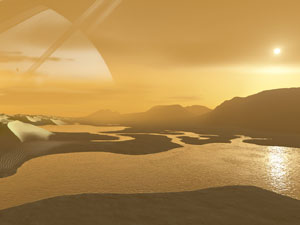Evidence grows for Life on Titan

The Evidence of life on Titan (the largest of Saturns moons) has grown recently thanks to the Cassini spacecraft. Titan is a very different place than Earth, in size it's about 50% bigger than Earth's moon and is the second biggest moon in the solar system (Jupiter's moon Ganymede being the largest).
It is a rocky place, the only known natural satellite that has a dense atmosphere and the only object other than Earth that is known to have clear stable bodies of liquid on the surface.
As Titan's surface temperature is a very chilly ?179 °C (?290 °F) these liquid lakes are not water but methane and ethane with an atmosphere composed of mainly nitrogen with clouds of methane or ethane.
While this may seem like an unlikely environment to support life as we know it, this isn't the first evidence that Cassini has sent back suggesting the existance of life on Titan. Following the launch of the Huygens probe in 2005 that descended Titan's atmosphere and landed on the moon, Huygens sent much feedback including images and even video which showed the rocky, dry suface along with the lakes, It touched down on a soft, sandy beach and continued to send data for a full 90 minutes before dying.
Chris McKay of NASA's Ames Research Center in Moffett Field and Heather R Smith of the International Space University in Strasbourg, France suggested that exotic life forms could live in these lakes, based upon the Huygens probe data. The pictures and video are also compelling in the suggestion of life.
These creatures would survive by breathing in hydrogen gas, eating the organic molecule acetylene and thus exhaling methane in the process.
This supposition has been supported by life forms on earth that have been found in such inhospitable places like the underwater geothermal vents where creatures survive the harsh combination of toxic chemicals, high temperatures, high pressures, and total darkness.
Cassini has made 2 very important discovery's that give weight to the theory of life on Titan, namely that hydrogen is disappearing near Titan's surface and there is less acetylene than scientists would expect. The Scientists are quick to point out that there are non-biological reactions that could explain this, but it does strike as a remarkable coincidence.
Due to the extremely low temperatures on Titan, the way the non-biological processes happen (hydrogen combining with carbon in molecules to form methane) tends to suggest a biological reaction is actually more likely as at such lower temperatures any non-biological reactions would be much too slow to account for the disappearing hydrogen.
Jonathan Lunine of the University of Arizona in Tucson who is a member of the team involved in this reasearch says that it may not be possible to distinguish between biological and non-biological explanations without additional missions to Titan.
"The only way to know for sure would be to actually get hold of an organism and show that it is alive"
The Cassini-Huygens spacecraft is a joint venture by NASA, the European Space Agency (ESA) and the Italian Space Agency (ISA) and was launched in 1997 to study the planet Saturn and it's moons. It entered orbit of Saturn in 2004 and has been studying the planet and moons since then. Originally scheduled to last till 2008, the project has currently been expanded for at least 2 years and is likely to continue until 2017.
Originally discovered in 1655 by Dutch Astronomer Christiaan Huygens, Titan has been favoured by Science Fiction for more than 80 years and many authors have written stories that feature Titan, these have included such literary greats such as Robert Heinlein ("The Puppet Masters" and "The Rolling Stones"), Isaac Asimov ("Lucky Starr and the Rings of Saturn"), Arthur C Clarke ("Imperial Earth") and Larry Niven ("World of Ptavvs").
More recently Kim Stanley Robinson set Titan as a source of Nitrogen for the Terraforming of Mars (1996) and Stephen Baxter dedicated a whole novel to the enigmatic Moon - "Titan" (1997) tells the story of a manned mission to Titan which goes wrong and the Astronauts must struggle for survival on the inhospitable moon.The novel is noted for it's vivid depictions of a journey through the Saturnian system.
For now the reality remains a mystery and until a real manned mission to Titan happens this is unlikely to change.
News Archives
- August 2024
- July 2023
- April 2023
- February 2023
- September 2022
- March 2022
- February 2022
- July 2021
- June 2021
- April 2021
- March 2021
- January 2021
- October 2020
- September 2020
- June 2020
- March 2020
- May 2019
- January 2019
- November 2018
- January 2016
- September 2015
- August 2015
- July 2015
- June 2015
- May 2015
- April 2015
- March 2015
- January 2015
- October 2014
- June 2014
- April 2014
- March 2014
- February 2014
- January 2014
- December 2013
- November 2013
- October 2013
- September 2013
- June 2013
- May 2013
- April 2013
- March 2013
- January 2013
- December 2012
- November 2012
- August 2012
- July 2012
- June 2012
- May 2012
- April 2012
- March 2012
- February 2012
- January 2012
- December 2011
- November 2011
- October 2011
- September 2011
- August 2011
- July 2011
- June 2011
- May 2011
- April 2011
- March 2011
- February 2011
- January 2011
- December 2010
- November 2010
- October 2010
- September 2010
- August 2010
- July 2010
- June 2010
- May 2010
- April 2010
- March 2010
- February 2010
- January 2010
- December 2009
- November 2009
- October 2009
- September 2009
- August 2009
- July 2009
- June 2009
- May 2009
- April 2009
- March 2009
- February 2009
- January 2009
- December 2008
- November 2008
- October 2008
- September 2008
